Exercises (1559)
Jump forwards and shift backwards in a four-footed stance alternating ► bear crawl jump
Power
Individual work
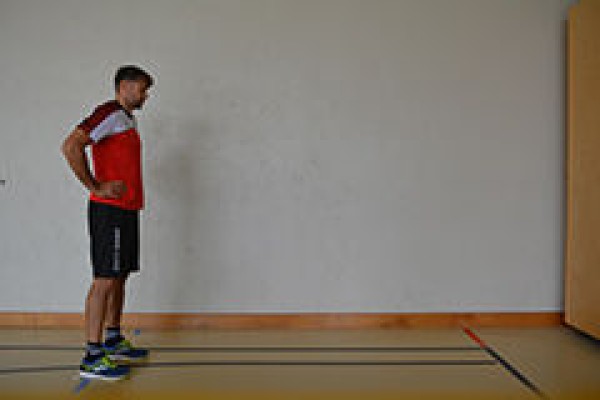


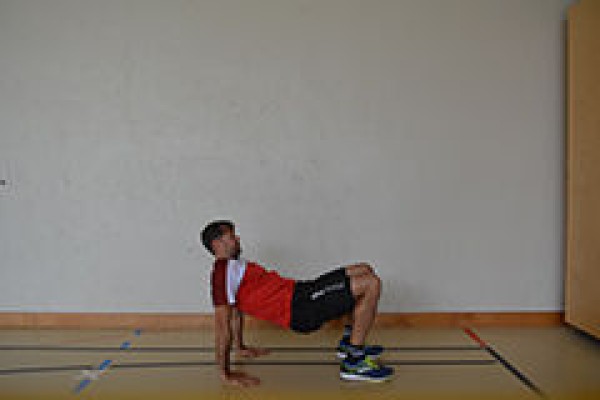
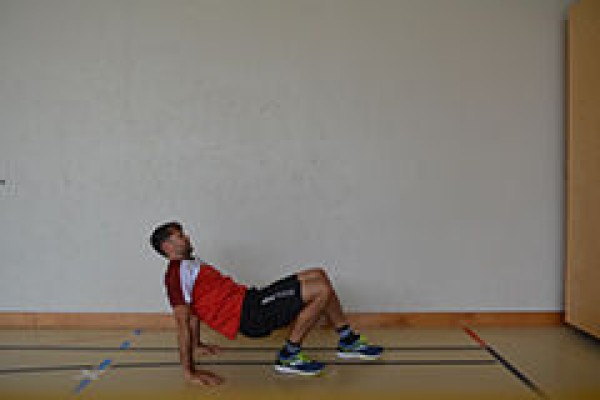

Stand with your hips wide apart, legs slightly bent and arms supported on your hips, jump forwards with both legs. Then, in an inverted four-footed stance (chest facing upwards, body supported on the hands and feet, fingertips pointing forwards), shift back to the starting point. When moving on all fours, the arms are almost fully extended, the legs are bent and the movement is in the direction of the arms.
Attention:
Always keep your knees behind the tips of your feet when jumping, pause briefly with your knees bent after each landing.
Lighten:
Bend your knees less (greater angle) when jumping and landing; jump less far forwards.
Harden:
Bend your knees more (smaller angle) when jumping and landing; jump with your arms in front of you; additional weight.
Variation:
Don't keep your arms supported or in front of you, but actively support the jump with your arms (with momentum).
2-4 weight cuffs/1 weight waistcoat ► Make the exercise more difficult (additional weight)
Jump to the side
Power
Individual work


Assault rifle lying flat on the ground or placed on the bipod rest. Stand upright next to the weapon, facing in the direction of travel, and then perform two-legged jumps sideways over the rifle.
Lighten:
With the rifle resting on the bipod support, perform deeper jumps closer to the butt.
Harden:
Rifle placed on the bipod rest: perform higher jumps over the barrel.
Variant:
Launch/land with the leg facing away from the assault rifle (single-leg jumps).
1 assault rifle (neutralised)
One-legged jump to the side
Power
Individual work
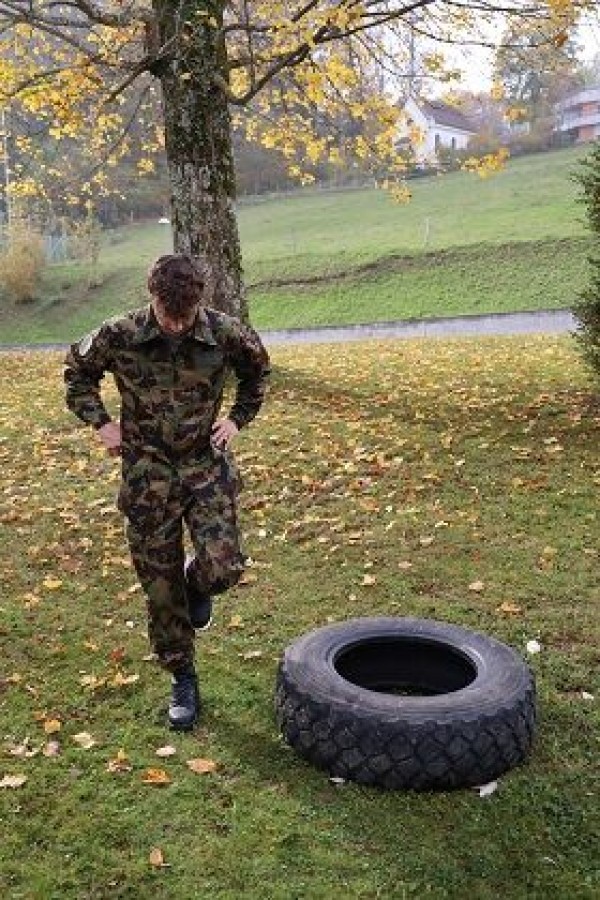

Stand on one leg outside the object (e.g. tyre) with the leg slightly bent. Tilt your upper body slightly forwards and jump onto the other leg inside the object and then jump back to the starting position.
Attention:
Risk of tripping.
Keep your knees stable and always behind your toes.
Lighten:
Jump without an object; jump over an object (e.g. combat backpack or helmet); lower cadence.
Harden:
Higher cadence; additional weight (on the feet).
1 tyre (10DM)
1 combat backpack/helmet ► make the exercise easier
2 weight cuffs/1 weight waistcoat ► make the exercise more difficult (additional weight)
One-legged jump to the side ► skater jump
Power
Individual work
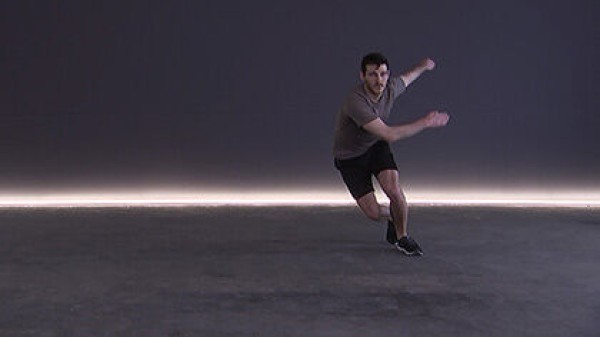

Stand on one leg with the leg slightly bent. Tilt your upper body forwards slightly and jump sideways onto the other leg. Hold your balance briefly in this position and then jump back to the other side.
Attention:
Keep your knees stable and always behind your toes.
Lighten:
Bend your knees less (greater angle); jump less to the side.
Harden:
Bend your knees more (smaller angle); hold additional weight (on your legs, shoulders, in front of your chest or in your hands).
2-4 weight cuffs/2 weight balls/dumbbells/1 weight vest/weight disc/sandbag/fighting rucksack ► Make the exercise more difficult (additional weight)
Standing and prone position alternating
Power
Individual work
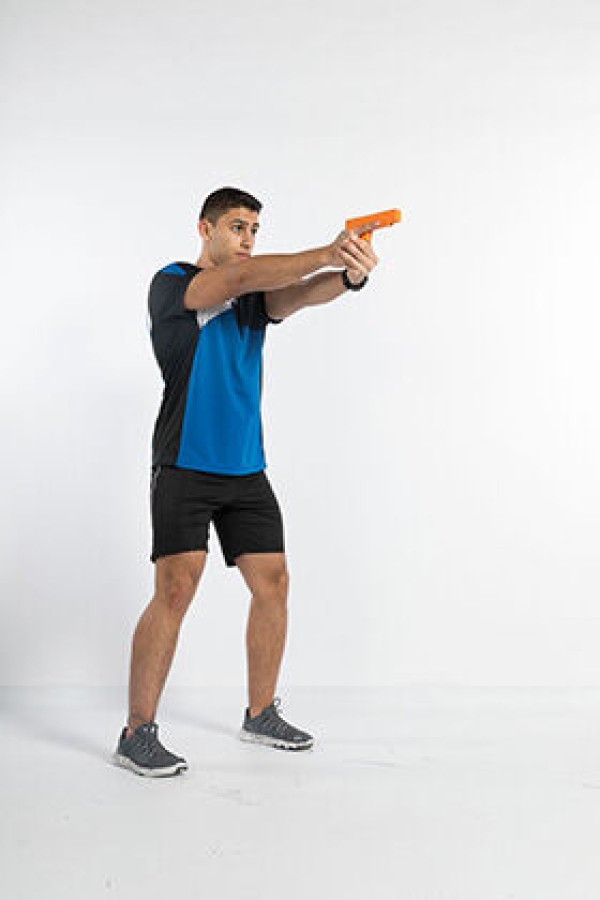

From the standing position, assume the prone position freely, observing the correct stance (see regulation 53.103: bend both knees simultaneously; kneel on the line of the hips; bend the upper body forwards and catch it with the weak hand; lie down without the weapon touching the ground, weapon and body form a line). Then stand up (reverse sequence of movements) and return to the standing position.
Attention:
The weapon is always pointed forwards.
1 pistol (neutralised)
Standing and prone position alternating
Power
Individual work

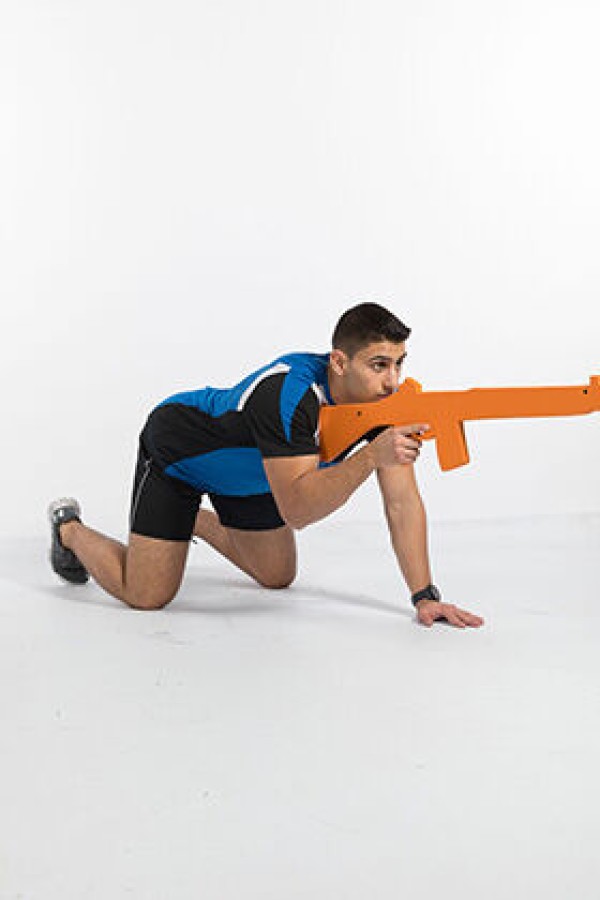

From the standing position, assume the prone position freely, observing the correct stance (see regulation 53.096: bend both knees simultaneously; kneel on the line of the hips; bend the upper body forwards and catch it with the weak hand; lie down so that the weapon and the body form a line). Then stand up (reverse movement sequence) and return to the standing position.
Attention:
The weapon is always pointed forwards.
1 assault rifle (neutralised)
Alternating standing and crouching position
Power
Individual work
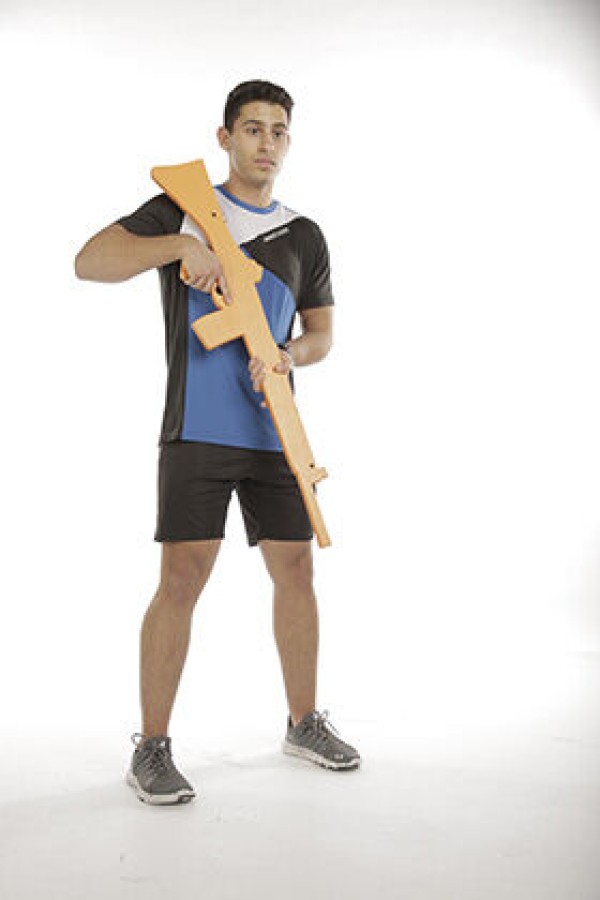
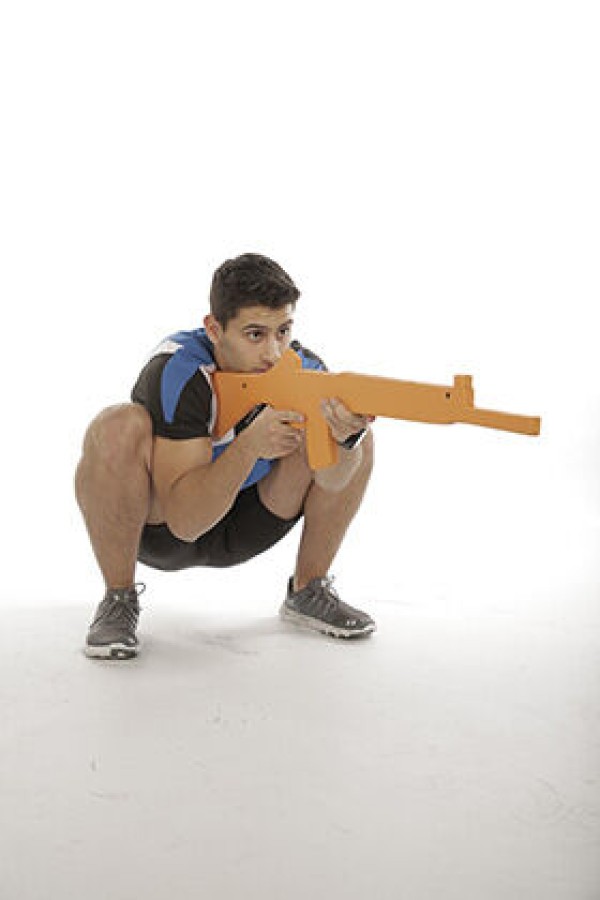
From the standing position, assume the crouching position, observing the correct stance (see regulation 53.096: bend both knees evenly, squat down; place feet flat on the ground; strike the weapon; both elbows are placed in front of the knees; the body is tilted slightly forwards). Then straighten up by stretching your legs and return to the standing position.
Attention:
The weapon is always pointed forwards.
1 assault rifle (neutralised)
Standing and kneeling position alternating
Power
Individual work


From the standing position, take up the position kneeling (on one knee), observing the correct stance (see regulation 53.103: take a step forwards with the weak leg over an imaginary line pointing from the tip of the strong foot to the target; bend both knees simultaneously; sit on the strong heel; bend the strong knee 45° from the direction of the shot; rest the weak elbow in front of or behind the weak knee). Then stand up by pushing off the front foot and return to the standing position.
Attention:
Weapon is always pointed forwards.
1 pistol (neutralised)
Standing and kneeling position alternating
Power
Individual work
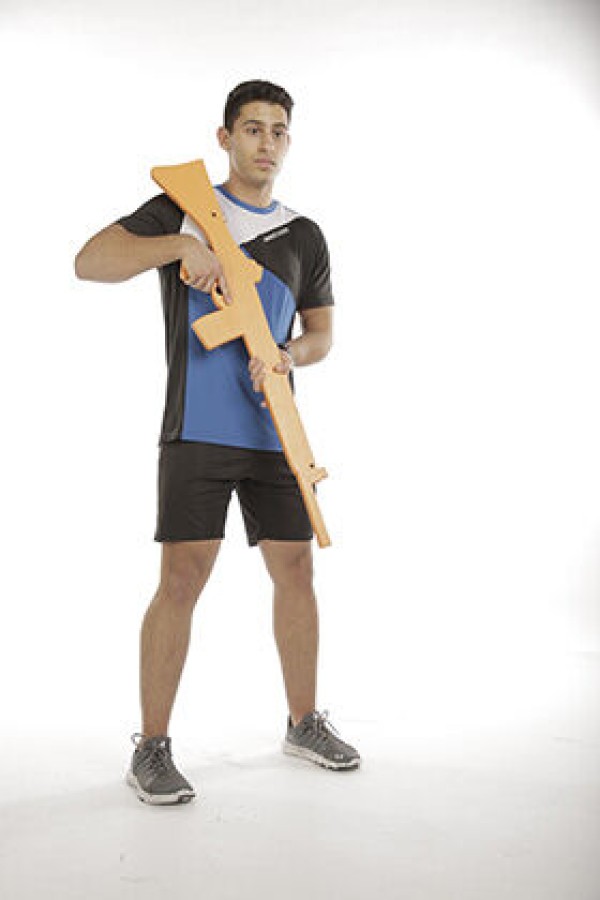

From the standing position, assume the kneeling position, observing the correct stance (see regulation 53.096: take a step forward in front of the strong leg with the weak leg, crossing the imaginary line from the strong leg to the target; bend both knees simultaneously, sit on the strong heel; the strong knee is bent 45 degrees from the direction of the shot; support the weak elbow slightly in front of or behind the weak knee). Then stand up by pushing off the front foot and return to the standing position.
Attention:
The weapon is always pointed forwards.
1 assault rifle (neutralised)
Standing and kneeling alternately
Power
Individual work
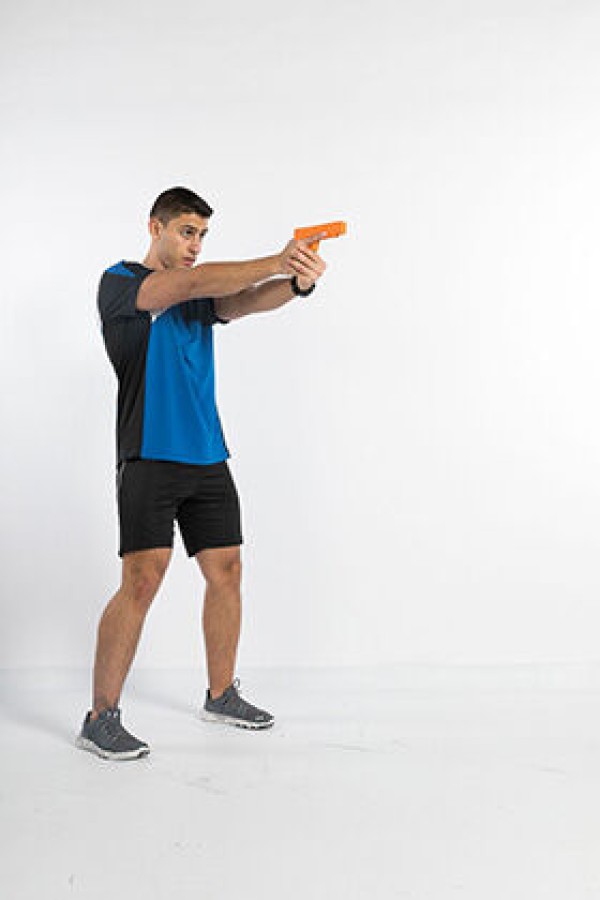
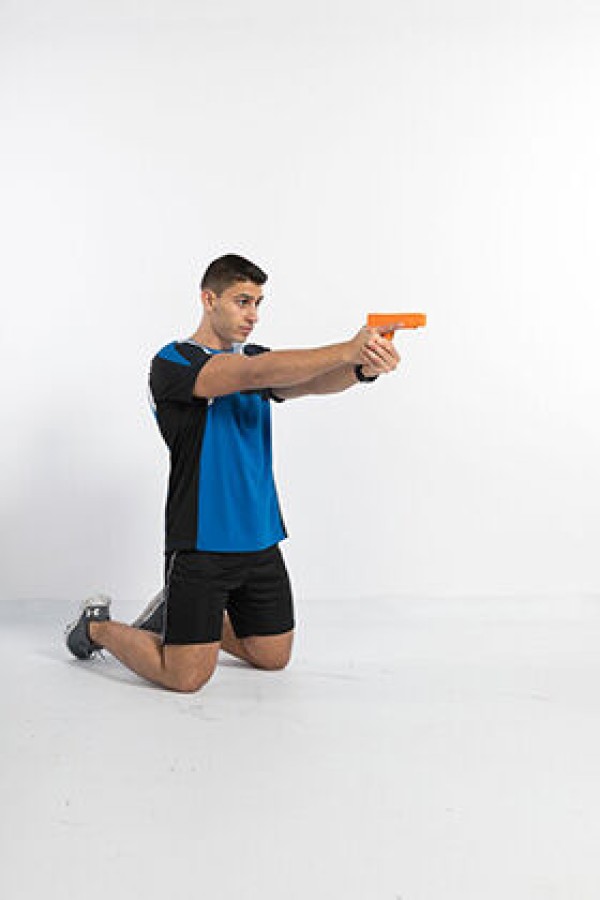
From the standing position, assume the kneeling position (on both knees), observing the correct stance (see regulation 53.103: starting position is the standing position; straighten the back and bend both knees at the same time; go to the ground with both knees). Then return to the standing position.
Attention:
The weapon is always pointed forwards.
1 pistol (neutralised)
Standing and supine position alternating (left) ► turkish get up
Power
Individual work

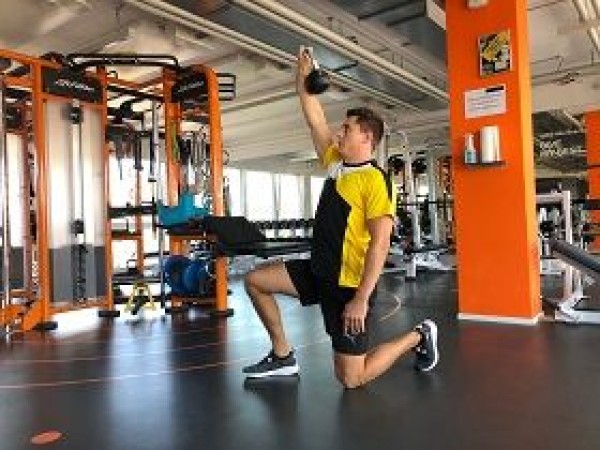
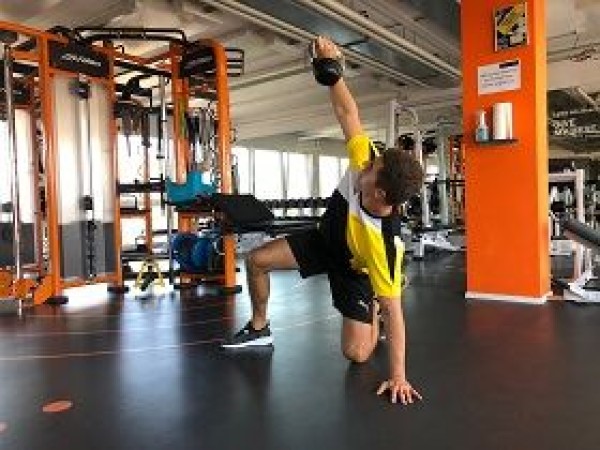



From the lying position (supine position), you move through various intermediate positions to the upright position, whereby the main focus is on holding the weight (dumbbell or kettlebell) in one hand overhead in a stable position and always working with a stretched back.
As a starting position, the weight is held in a supine position with one arm (left) almost outstretched at chest height (arm pointing upwards), the leg (left) on the same side where the weight is held is bent (foot placed on the floor). Firstly, the shoulders are lifted using the forearm of the arm resting on the floor (right). Then rest the free arm on the hand to lift the whole upper body away from the floor. The hips are then pushed upwards and the outstretched leg (right) is pulled under the body and brought backwards into a kneeling position (half kneeling position with one hand resting on the floor). The arm that is currently still supporting you (right) is then finally lifted off the floor to a half-kneeling position with the upper body upright. A lunge is used to assume the final standing position. Reverse the sequence of movements to return to the starting position lying on the floor.
Starting position:
- Supine position
- Leg bent and positioned on the side of the weight
- Weight held in front of you with one arm almost straight (arm pointing firmly upwards)
- Abdominal and gluteal muscles are tensed
- Gaze is directed towards the weight
Final position:
- Stand upright with a straight back
- Stabilise the weight overhead with an almost outstretched arm
Attention:
This exercise places extremely high demands on mobility and stability, which is why it is only suitable for advanced exercisers. Distribute the weight over the entire foot during the movement sequence
1 dumbbell/kettlebell
Standing and supine position alternating (left) ► turkish get up
Power
Individual work

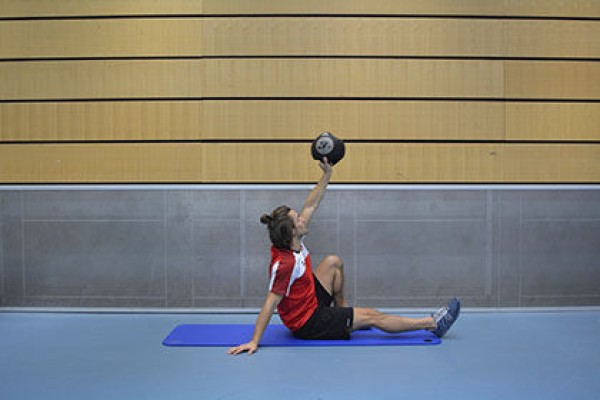
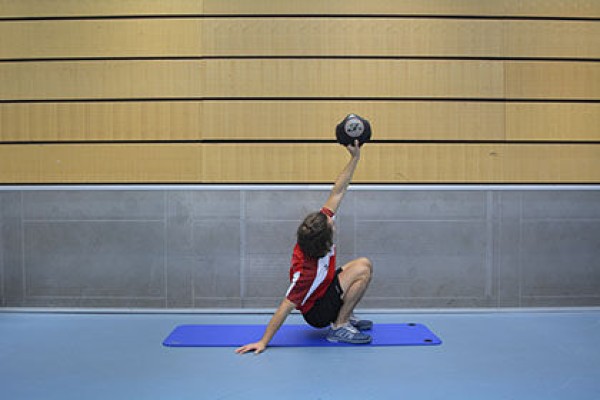

From the lying position (supine position), you move through various intermediate positions to the upright position, whereby the main focus is on holding the weight (dumbbell or kettlebell) in one hand overhead in a stable position and always working with a stretched back.
As a starting position, the weight is held in a supine position with one arm (right) almost outstretched at chest height (arm facing upwards), the leg (right) on the same side where the weight is held is bent (foot on the floor). Firstly, the shoulders are lifted using the forearm of the arm resting on the floor (left). Then rest the free arm on the hand to lift the whole upper body away from the floor. The hips are then pushed upwards and the outstretched leg (left) is pulled under the body and brought backwards into a kneeling position (half kneeling position with one hand resting on the floor). The arm that is currently still supporting you (left) is then finally lifted off the floor to a half-kneeling position with the upper body upright. A lunge is used to assume the final standing position. Reverse the sequence of movements to return to the starting position lying on the floor.
Starting position:
- Supine position
- Leg bent and positioned on the side of the weight
- Weight held in front of you with one arm almost straight (arm pointing firmly upwards)
- Abdominal and gluteal muscles are tensed
- Gaze is directed towards the weight
Final position:
- Stand upright with a straight back
- Stabilise the weight overhead with an almost outstretched arm
Attention:
This exercise places extremely high demands on mobility and stability, which is why it is only suitable for advanced exercisers. Distribute the weight over the entire foot during the movement sequence
1 dumbbell/kettlebell
Standing and supine position alternating (right) ► turkish get up
Power
Individual work


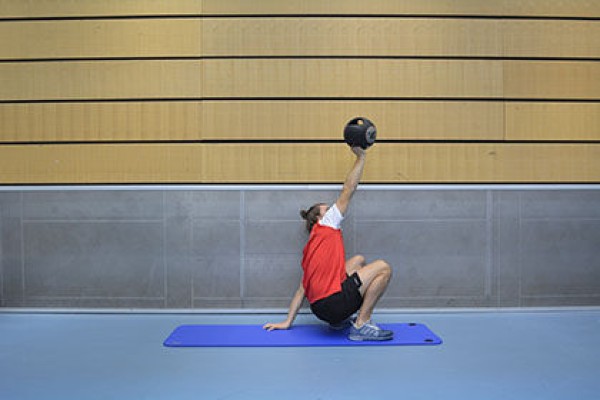
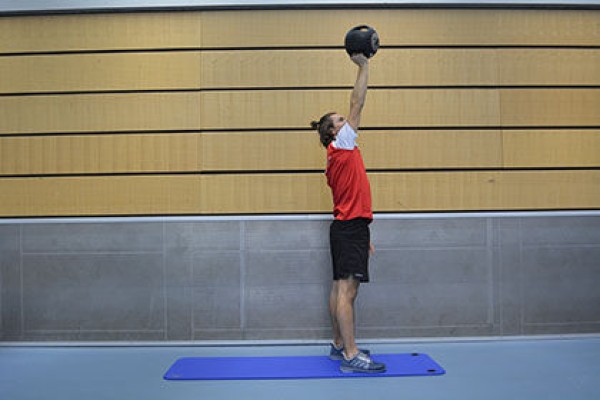
From the lying position (supine position), you move through various intermediate positions to the upright position, whereby the main focus is on holding the weight (dumbbell or kettlebell) in one hand overhead in a stable position and always working with a stretched back.
As a starting position, the weight is held in a supine position with one arm (right) almost outstretched at chest height (arm facing upwards), the leg (right) on the same side where the weight is held is bent (foot on the floor). Firstly, the shoulders are lifted using the forearm of the arm resting on the floor (left). Then rest the free arm on the hand to lift the whole upper body away from the floor. The hips are then pushed upwards and the outstretched leg (left) is pulled under the body and brought backwards into a kneeling position (half kneeling position with one hand resting on the floor). The arm that is currently still supporting you (left) is then finally lifted off the floor to a half-kneeling position with the upper body upright. A lunge is used to assume the final standing position. Reverse the sequence of movements to return to the starting position lying on the floor.
Starting position:
- Supine position
- Leg bent and positioned on the side of the weight
- Weight held in front of you with one arm almost straight (arm pointing firmly upwards)
- Abdominal and gluteal muscles are tensed
- Gaze is directed towards the weight
Final position:
- Stand upright with a straight back
- Stabilise the weight overhead with an almost outstretched arm
Attention:
This exercise places extremely high demands on mobility and stability, which is why it is only suitable for advanced exercisers. Distribute the weight over the entire foot during the movement sequence
1 dumbbell/kettlebell
Standwaage
Power
Individual work



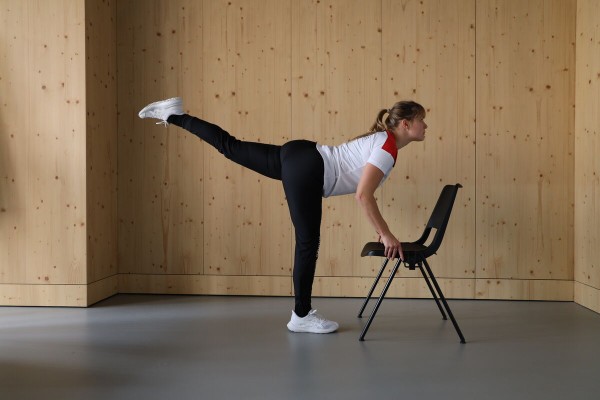
Stand upright, facing the chair. At the same time, tilt your upper body forwards (keep your upper body horizontal to the floor) and raise your practically stretched free leg up to the height of your buttocks. To keep your balance better, support your upper body with your arms on the seat of the chair. In the end position, the leg and upper body are roughly in line. The position in the shape of the letter "T" is also known as the standing balance. Then raise the upper body and lower the leg back to the starting position. Switch sides after each execution (change the supporting leg/playing leg).
Attention:
Keep your back straight at all times (tense your torso), distribute your weight over the entire foot (supporting leg).
1 (office) chair
Standing scale (left)
Power
Individual work
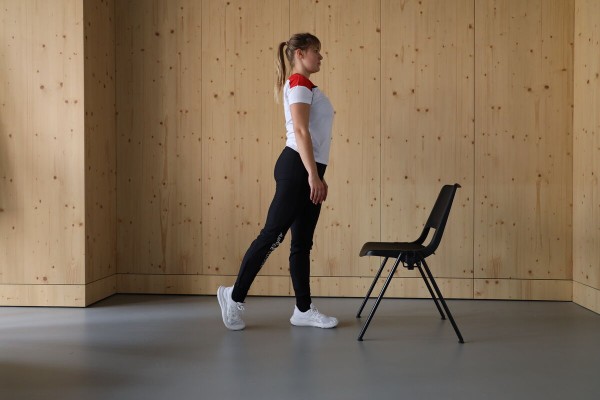
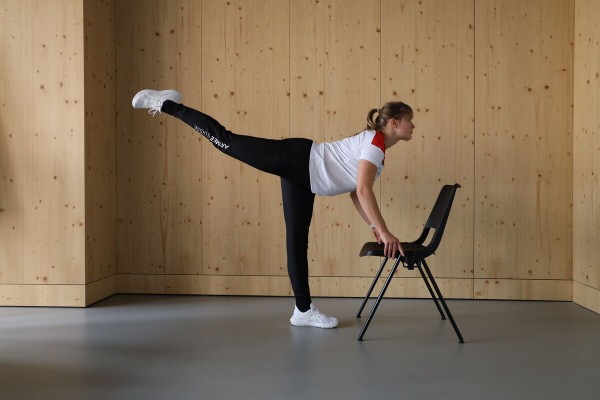
Stand upright, slightly offset, with the free leg (right) slightly further back than the supporting leg (left) and facing the chair. At the same time, tilt the upper body forwards (keep the upper body horizontal to the floor) and raise the practically stretched free leg to the height of the buttocks. To keep your balance better, support your upper body with your arms on the seat of the chair. In the end position, the leg and upper body are roughly in line. The position in the shape of the letter "T" is also known as the standing balance. Then raise your upper body and lower your leg back to the starting position.
Attention:
Keep your back straight at all times (tense your core) and distribute your weight over your entire foot (standing leg).
1 (office) chair
Standwaage (right)
Power
Individual work


Stand upright, slightly offset, with the free leg (left) slightly further back than the supporting leg (right) and facing the chair. At the same time, tilt the upper body forwards (keep the upper body horizontal to the floor) and lift the practically stretched free leg up to the height of the buttocks. To keep your balance better, support your upper body with your arms on the seat of the chair. In the end position, the leg and upper body are roughly in line. The position in the shape of the letter "T" is also known as the standing balance. Then raise your upper body and lower your leg back to the starting position.
Attention:
Keep your back straight at all times (tense your core) and distribute your weight over your entire foot (standing leg).
1 (office) chair
Pushing an object while stationary
Power
Individual work

Push an object lying on the ground (e.g. a tyre) over a certain distance (back and forth). Choose a short distance for multiple pushes (5-10m),
Attention:
Keep your back straight.
Lighten:
Less resistance.
Harden:
More resistance.
1 tyre (DURO)
1 tyre (PUCH) ► Make the exercise easier
1 tyre (10DM) ► Make the exercise more difficult
Pushing an object while stationary
Power
Individual work


Push an inverted vaulting box top including a centre section (possibly filled with medicine balls) over a certain distance (back and forth) (push the bob). Choose a short distance for multiple pushes (5-10m).
Attention:
Keep your back straight.
Lighten:
Less (no) additional weight (medicine balls).
Harden:
Additional weight (medicine balls).
2 vaulting box elements (incl. upper part)
x medicine balls
Stretch jump with momentum from supine position ► reverse burpee
Power
Individual work



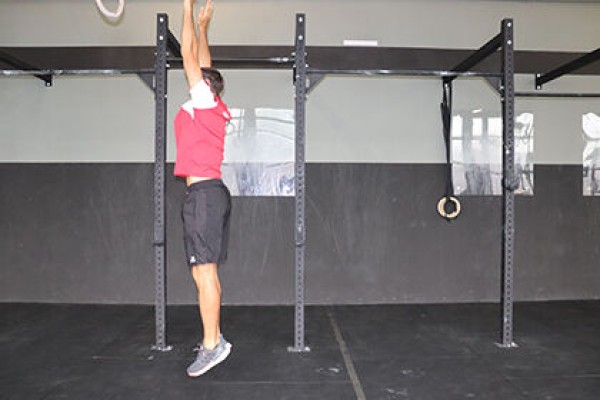
From a shoulder-width stance, move into a squat position (arms pointing diagonally downwards in front) and then drop into a supine position. The outstretched arms are extended overhead (along the floor) and the bent legs are stretched out so that they are pointing towards the sky (upwards). The arms are then brought back in front of the body in a flowing movement so that the momentum can be utilised to return to the standing position. Once in the standing position, immediately perform a stretch jump into the air, landing in the starting position to begin the exercise again.
Attention:
Knee of the training leg should remain as centred as possible over the foot.
Lighten:
Arms support the movement more clearly (more momentum); lower height during the stretch jump (or just straighten the upper body).
Harden:
Additional weight.
2-4 weight cuffs ► Make the exercise more difficult (additional weight)
Support backwards
Power
Individual work

Inverted support (inverted push-up position, the outstretched legs and upper body practically form a line, the legs are supported on the heels and the upper body on the outstretched arms, with the face/gaze pointing upwards). Hold the position.
Attention:
Head, torso, hips and knees form a line (do not let your buttocks sag, tense your stomach), place your hands under your shoulders.
Lighten:
Bend your legs slightly.
Harden:
Additional weight (on the hips); unstable support for the legs (arms probably too difficult).
1 weight vest/weight disc/sandbag ► to make the exercise more difficult (additional weight)
1 ball/balance cushion/balance board ► to make the exercise more difficult (unstable surface)
Support backwards
Power
Individual work
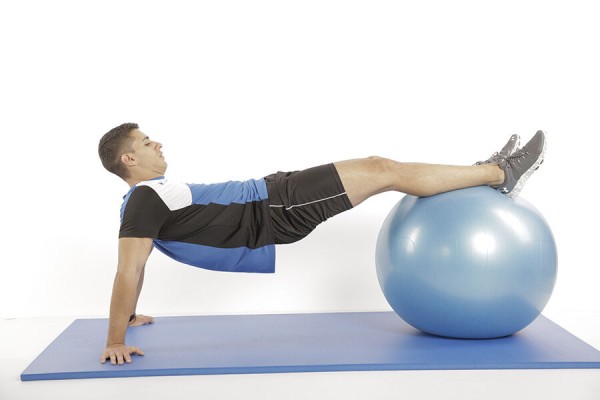
Inverted support (inverted push-up position, the outstretched legs and upper body practically form a line, support the upper body on the outstretched arms) with the feet (calves) placed on the exercise ball and the buttocks pressed upwards (full body stretch). Hold the position you have assumed.
Attention:
Head, torso, hips and knees practically form a line (do not let your buttocks sag, tense your stomach), place your hands under your shoulders.
Lighten:
Exercise ball closer to your buttocks.
Harden:
Additional weight (on the hips).
1 exercise ball
1 weight vest/weight disc/sandbag ► Make the exercise more difficult (additional weight)
Support backwards
Power
Individual work

Inverted support (inverted push-up position, the outstretched legs and upper body practically form a line, the legs are supported by the heels on the balance board and the upper body on the outstretched arms, so the face/gaze is pointing upwards). Hold the position.
Attention:
Head, torso, hips and knees form a line (don't let your buttocks sag, tighten your stomach), place your hands under your shoulders.
Lighten:
Without the balance board; bend your legs slightly.
Harden:
Additional weight (on the hips).
1 balance board
1 weight vest/weight disc/sandbag ► Make the exercise more difficult (additional weight)
Supination of the forearm in the sitting position (left)
Power
Individual work
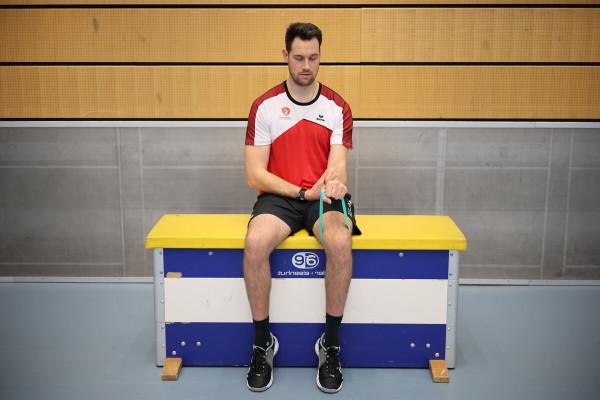
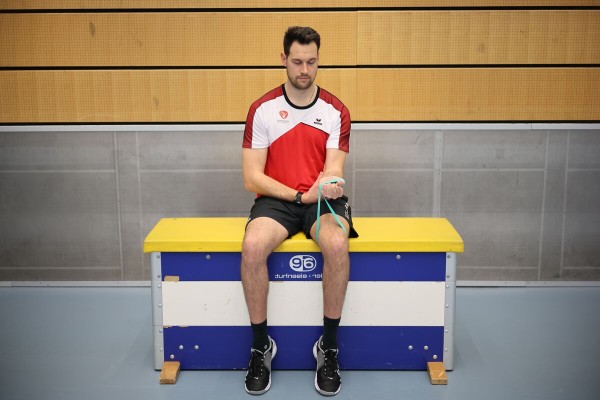
While seated, place an elasticated band around the (left) thigh and grasp the band with the (left) hand, with the back of the hand pointing upwards. The arm holding the band is bent so that the upper arm is against the body and the lower arm is pointing forwards (90 degree angle at the elbow joint). The other (right) arm fixes the training arm by holding the forearm at the elbow. From this position, perform an outward rotation (supination) with the arm so that the back of the hand points downwards in the end position.
Attention:
The movement only takes place in the forearm, the upper arm remains stable.
Lighten:
Choose an elastic band with less resistance.
Harden:
Choose an elastic band with greater resistance.
1 mini-band
1 seating option (e.g. chair, plyo box or vaulting box)
Supination of the forearm in the sitting position (right)
Power
Individual work
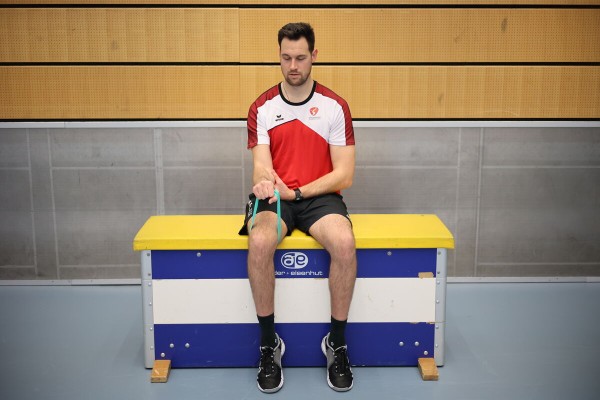

While seated, place an elasticated band around the (right) thigh and grasp the band with the (right) hand, with the back of the hand pointing upwards. The arm holding the band is bent so that the upper arm is against the body and the lower arm is pointing forwards (90 degree angle at the elbow joint). The other (left) arm secures the training arm by holding the forearm at the elbow. From this position, perform an outward rotation (supination) with the arm so that the back of the hand points downwards in the end position.
Attention:
The movement only takes place in the forearm, the upper arm remains stable.
Lighten:
Select an elastic band with less resistance.
Harden:
Select an elastic band with greater resistance.
1 mini-band
1 seating option (e.g. chair, plyo box or vaulting box)
Skip
Power
Individual work

Round race with (3) obstacles (e.g. hurdles or a rope stretched between two stakes). The aim is to jump over the obstacles.
Attention:
Suspend the landing with your legs (lower your buttocks).
Lighten:
Lower obstacles.
Harden:
Higher obstacles.
Variant:
Jump up again immediately after landing (explosive power) or take a roughly right angle with your knees when landing and hold this position briefly before jumping off again.
2 stakes/1 rope or 1 hurdle = 1 obstacle